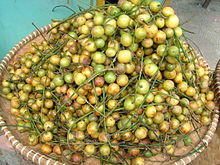
The Malay Peninsula is a peninsula in Mainland Southeast Asia. The landmass runs approximately north–south (N-S) and, at its terminus, is the southernmost point of the Asian continental mainland. The area contains Peninsular Malaysia, Southern Thailand, and the southernmost tip of Myanmar (Kawthaung). The island country of Singapore also has historical and cultural ties with the region. The indigenous people of the peninsula are the Malays, an Austronesian people.
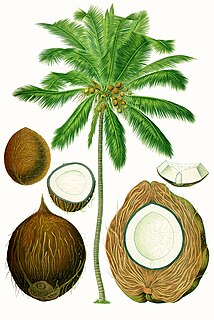
The coconut tree is a member of the palm tree family (Arecaceae) and the only living species of the genus Cocos. The term "coconut" can refer to the whole coconut palm, the seed, or the fruit, which botanically is a drupe, not a nut. The name comes from the old Portuguese word coco, meaning "head" or "skull", after the three indentations on the coconut shell that resemble facial features. They are ubiquitous in coastal tropical regions and are a cultural icon of the tropics.
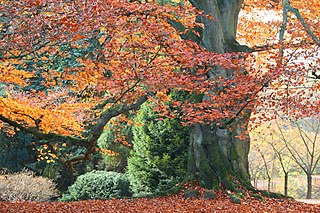
Beech (Fagus) is a genus of deciduous trees in the family Fagaceae, native to temperate Europe, Asia and North America. Recent classifications recognize 10 to 13 species in two distinct subgenera, Engleriana and Fagus. The Engleriana subgenus is found only in East Asia, distinctive for their low branches, often made up of several major trunks with yellowish bark. The better known Fagus subgenus beeches are high-branching with tall, stout trunks and smooth silver-grey bark. The European beech is the most commonly cultivated.

The Indo-Pacific, sometimes known as the Indo-West Pacific or Indo-Pacific Asia, is a biogeographic region of Earth's seas, comprising the tropical waters of the Indian Ocean, the western and central Pacific Ocean, and the seas connecting the two in the general area of Indonesia. It does not include the temperate and polar regions of the Indian and Pacific oceans, nor the Tropical Eastern Pacific, along the Pacific coast of the Americas, which is also a distinct marine realm.

Aleurites moluccanus, the candlenut, is a flowering tree in the spurge family, Euphorbiaceae, also known as candleberry, Indian walnut, kemiri, varnish tree, nuez de la India, buah keras, godou, kukui nut tree, and rata kekuna.

Malesia is a biogeographical region straddling the Equator and the boundaries of the Indomalayan and Australasian realms, and also a phytogeographical floristic region in the Paleotropical Kingdom. It has been given different definitions. The World Geographical Scheme for Recording Plant Distributions split off Papuasia in its 2001 version.
Indo-Pacific is a hypothetical language macrofamily proposed in 1971 by Joseph Greenberg and now believed to be spurious. It grouped together the Papuan languages of New Guinea and Melanesia with the languages of the Andaman Islands and, tentatively, the languages of Tasmania, both of which are remote from New Guinea. The valid cognates Greenberg found turned out to be reflexes of the less extensive Trans–New Guinea family. Recently the Kusunda language, which is generally seen as a language isolate, is also included in the Indo-Pacific proposal. Greenberg did not include "Australian" in his original 1971 proposal.
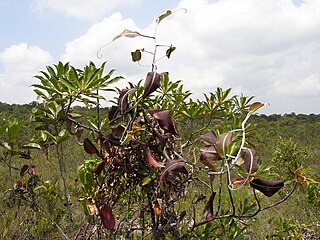
The Sundaland heath forest, also known as Kerangas forest, is a type of tropical moist forest found on the island of Borneo, which is divided between Brunei, Indonesia, and Malaysia, as well as on the Indonesian islands of Belitung and Bangka, which lie to the west of Borneo.

Menteng is the south-central district of Central Jakarta, one of the administrative municipalities in the capital city Jakarta, Indonesia.
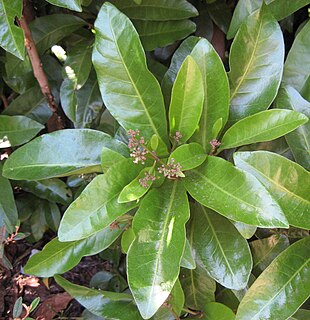
Pisonia is a genus of flowering plants in the four o'clock flower family, Nyctaginaceae. It was named for Dutch physician and naturalist Willem Piso (1611–1678). Certain species in this genus are known as catchbirdtrees, birdcatcher trees or birdlime trees because they catch birds. The sticky seeds are postulated to be an adaptation of some island species that ensures the dispersal of seeds between islands by attaching them to birds, and also allows the enriching of coralline sands. These island species include P. brunoniana of Australasia and Polynesia and P. umbellifera, which is widespread in the tropical Indo-Pacific region.

Intsia bijuga, commonly known as Borneo teak, Johnstone River teak, Kwila, Moluccan ironwood, Pacific teak, scrub mahogany and vesi, is a species of flowering tree in the family Fabaceae, native to the Indo-Pacific. It ranges from Tanzania and Madagascar east through India and Queensland, Australia, Papua New Guinea to the Pacific islands of Fiji and Samoa.It grows to around 50 metres tall with a highly buttressed trunk. It inhabits mangrove forests. Intsia bijuga differ from Intsia palembanica in the number of leaflets that make up their compound leaves.

The tembusu is a large evergreen tree in the family Gentianaceae, native to Southeast Asia. It is the Malay name for Cyrtophyllum fragrans.

Syzygium malaccense is a species of flowering tree native to Malesia and Australia. It is one of the species cultivated since prehistoric times by the Austronesian peoples. They were carried and introduced deliberately to Remote Oceania as canoe plants. In modern times, it has been introduced throughout the tropics, including many Caribbean countries and territories.
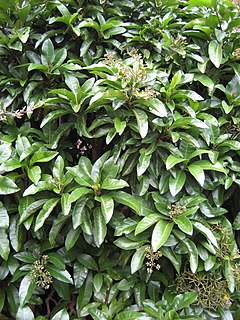
Pisonia brunoniana is a species of flowering tree in the family Nyctaginaceae that is native to New Zealand, Norfolk Island, Lord Howe Island and Hawaiʻi. The common names in New Zealand are parapara or birdcatcher tree.
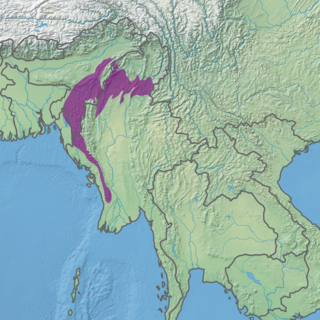
The Mizoram-Manipur-Kachin rain forests is a subtropical moist broadleaf forest ecoregion which occupies the lower hillsides of the mountainous border region joining India, Bangladesh, and Burma (Myanmar). The ecoregion covers an area of 135,600 square kilometres (52,400 sq mi). Located where the biotas of the Indian Subcontinent and Indochina meet, and in the transition between subtropical and tropical regions of Asia, the Mizoram-Manipur-Kachin rain forests are home to great biodiversity. The WWF rates the ecoregion as "Globally Outstanding" in biological distinctiveness.

The Borneo Orangutan Survival (BOS) Foundation is an Indonesian non-profit non-governmental organization founded by Dr. Willie Smits in 1991 and dedicated to the conservation of the endangered Bornean orangutan and its habitat through the involvement of local people. It is audited by an external auditor company and operates under the formal agreement with the Indonesian Ministry of Forestry to conserve and rehabilitate orangutans. The BOS Foundation manages orangutan rescue, rehabilitation and re-introduction programmes in East and Central Kalimantan. With more than 400 orangutans in its care and employing more than 440 people at a 10 sites BOS Foundation is the biggest non-human primate conservation non-governmental organization worldwide. Nyaru Menteng and Samboja Lestari are the BOS Foundation sites that have received most extensive media coverage. Nyaru Menteng, founded by Lone Drøscher Nielsen, has been the subject of a number of TV series, including Orangutan Diary, Orangutan Island and the series Orangutan Jungle School, airing since 2018.

Littoraria scabra, common name : the mangrove periwinkle, is a species of sea snail, a marine gastropod mollusk in the family Littorinidae, the winkles or periwinkles.
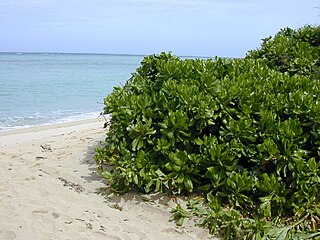
Scaevola taccada, also known as beach cabbage, sea lettuce, beach naupaka, naupaka kahakai (Hawaiian), magoo (Divehi), merambong (Malay), bapaceda or papatjeda, ngahu (Tongan) is a flowering plant in the family Goodeniaceae found in coastal locations in the tropical areas of the Indo-Pacific. It is a common beach shrub throughout the Arabian Sea, the tropical Indian Ocean and the tropical islands of the Pacific Ocean.
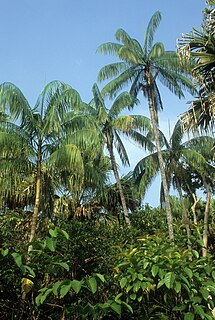
Oncosperma tigillarium is an Asian species of palm tree in the family Arecaceae.

Rhizophora mucronata is a species of mangrove found on coasts and river banks in East Africa and the Indo-Pacific region.
